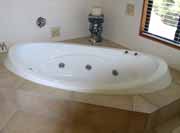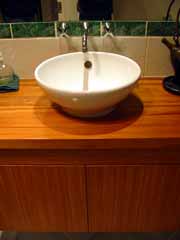An Introduction to Bathroom Planning
The bathroom is often the smallest space in a house and the most frequently used, therefore bathroom planning is the key to a successful bathroom.
It is vital to plan what are the essential items required within the space as sometimes we cannot fit everything in and sacrifices or compromises have to be made.
For example the length of a bath, the width of the shower and vanity, towel rail and heater space.
Many homes have a separate toilet , this generally creates a small narrow room housing only a WC and sometimes a slim wash hand basin, and a tight fitting room including a shower over the bath and a vanity. By opening up the space and combining the two a separate shower is often able to be included.
As with any form of design or decoration, there are always questions to be asked. What colour fittings and fixtures? What type of tap / faucet? The selection of shower fittings, to use a slide adjustable fitting or a fixed head? What type of bath? What materials are best used? Tile floor or vinyl? Inset basin or a formed unit? We could go on forever, and that is what it feels like when you decide to embark on renovating or building from new a bathroom.

Jump in and try out the baths for size.

A porcelain vessel inserted into a rimu timber vanity unit.
When you go to bed dreaming about taps and shower heads you know that it’s time for a break. In our section on bathrooms, we hope to take away some of the “nightmares” about fitting and fixture selection. As with everything in life, it is hard to get impartial advice, especially in the home decorating arena, as most shops you visit want to sell you their product. By giving you the information before you visit the shops it will be you that is asking the questions , as you will have drawn up some parameters that you will work from.
Bathroom Planning
That is were we will start – .
- Write down a list of everything that you want in the space.
- Write down a list of everything that you will have to do ie plumbing and electrical, carpentry, tiling, painting etc.
- Think of where you want to put heaters towel rails, light switches, toilet roll holders etc, leave nothing to chance.
- Decide on what type/style you want. ie Clean and crisp fittings and fixtures and white tiled walls and floor or warm and cosy terracotta tiled floor, textured wallpapered walls, recessed lights, brass fittings or timber moldings, timber matchboarded walls, heritage porcelain fittings, spoked taps.
This is where you say “but how do I choose which type of style?”
We can only guide you here, this will come down to particular taste, as well as the style of the rest of your house, the way in which you use the room, what the trends are at the time and what products are available .
You have already made the first step by reading this – research! Look at magazines, other peoples homes, books, visit show homes, show rooms and building centres. Then you will start to get a feel as to what you like.
The biggest fear is “what if I don’t like it when it’s done?”
This often curbs the creativity and the decisions are made to keep the space simple. There is nothing wrong with that but a little bit of personal flair makes all the difference. Don’t be afraid to make decisions that are slightly different. That is what design is all about, as long as you can justify why, then go for it. Add the textured tile border in the shower with matching soap holder, or paint the ceiling aubergine and the cork tiles white, or paint stripes horizontally around the walls, carpet the floor and splash out on the spa bath. The choices are endless.
One last thing to remember is, try all the fittings and fixtures before you buy them, get into the baths and lie down and make sure you fit into them, sit on the toilets, pretent to wash your hands in the basin, turn the taps or levers. Make sure you know what you are getting for your money. This is another way to feel positive about your choices. There are 1001 things that can go terribly wrong in any job that you do, but by simply planning and making the correct selections that suit you there can also be 1001 things that go absolutely perfectly.
